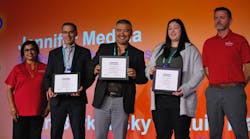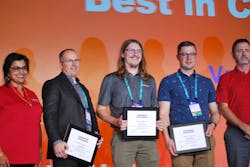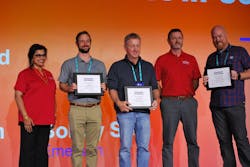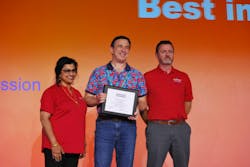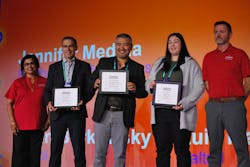Five presentations awarded best-in-conference at Emerson Exchange
Sports, theater and other activities are always better in person, and the technical sessions at Emerson Exchange Americas 2022 were no exception.
After two years of online presentations, this year’s event was highlighted by more than 300 live sessions, which were attended by close to 2,500 visitors. Of these, just 16 sessions were nominated by the Emerson Exchange 2022 board of directors for Best-in-Conference Awards, and just five winners were announced at the event’s closing luncheon.
Valve upgrades trim maintenance costs at K+S Potash
The first of five the winners announced (in no particular order) was “Fisher Control Valve—Reducing Maintenance Spend via Control Valve Upgrades at K+S,” which was presented by Michael Holmes of K+S Potash Canada, Duane Lunde of Spartan Controls and Nolan Vollstedt of Emerson.
K+S experienced challenges common to other new greenfield facilities, where designed process conditions differed from actual, day-to-day operating conditions. This led to control valve assemblies that experienced control issues, as well as shorter-than-desired control valve lifespans than desired. The session reviewed a control valve upgrade program developed with Fisher Control Valves and Bettis actuators and Fisher FIELDVUE digital controllers by selecting upgraded materials, control valve designs and actuators, and improved tuning parameters in FIELDVUE. K+S, Spartan and Emerson reported that upgraded materials in the devices showed significant benefits including exotic alloys such as R31233 (Ultimet), SuperDuplex CD3MWCuN SST and tungsten carbide coatings.
Better sugar extraction at New Belgium Brewing
The second winner announced was “Bringing Rosemount and Micro Motion together to improve brewing at New Belgium,” which was presented by Matthew Gilliland of New Belgium Brewing, and Brent Pankonien and Bobby Seal, both of Emerson.
New Belgium reported that an efficient brew process relies on good sugar (starch) extraction from the grain bill. Sparging is the standard process for washing grain while it is in the lauter tun to extract as much sugar as possible. During the sparge process, the density continually decreases because the sugar concentration decreases until most of the sugar is extracted. Brewmasters know approximately how long to sparge based on experience and the type of grain used in the specific beer being made. However, subtle changes in the grain from year-to-year and other process variations can result in small changes in the optimal sparge time. Using a Micro Motion Coriolis meter and Rosemount’s Xwell Technology, measurement of the hot wort increased the efficiency of the sparging process at New Belgium.
Transfer assistant boosts safety at Savannah River
The third best-in-conference presentation announced was “Transfer Assistant: Helping an Operator in a manual-Only World,” which was presented by Jim Coleman of Savannah River Mission Completion (SRMC).
A “transfer assistant” at SRMC’s facility is a set of automation and graphics that help operators perform tank-to-tank transfers. It aggregates information and controls, monitors a transfer sequence, and provides mass-balance information. But most importantly, it promotes error reduction and safety. While automatic transfers are common in batch environments, they were virtually unknown in SRMC’s manual transfer environment. The presentation showed how automation and graphics can perform desired functions in a non-batch environment, and how DeltaV’s programming solve SRMC’s transfer problem.
SoCalGas pioneers the hydrogen-powered home
The fourth winning presentation announced was “SoCalGas Hydrogen Innovation Experience Achieves Goals of Decarbonization & Digitalization,” which was presented by Jennifer Medina of Southern California Gas Co. (SGC), and Brian Burkowsky and Luis Martin Del Campo, both of Caltrol.
SoCalGas's mission is to become the cleanest, safest and most innovative energy company in the U.S., so its goal in 2022 was to build a state-of-the-art demonstration project. The H2 Hydrogen Home project highlighted the role H2 could play in attaining California’s goal of achieving carbon neutrality. SCG worked with its Local Impact Partner, Caltrol, to provide an H2 blending solution and overall H2 home control using Emerson’s solutions for the first-of-its-kind application in the U.S. It included solar panels, battery storage, an electrolyzer to convert solar energy to green H2, a fuel cell to convert H2 back to electricity, and H2 blended with natural gas for use in the home. The solution included Emerson’s DeltaV safety instrumented system (SIS) and advanced process control (APC) software to help meet SCG’s Aspire 2045 goals.
Shell explores new frontiers in alarm management
Last but certainly not least, the fifth and final best-in-conference winner was “Shell’s Unique Approach to Alarm Management at a Major Greenfield Site,” which was presented by Sandeep Pampattiwar of Shell Polymers, Pennsylvania Chemicals Project, and Darwin Logerot and Carlos Pereia, both of Emerson.
Shell’s Pennsylvania Chemicals Project is a large-scale, grass-roots complex, including a world-class ethylene cracker and three polyethylene trains, currently under construction in Beaver County, Pa. Emerson was part of the project from early on as its main automation contractor (MAC), but it also provided alarm management expertise by developing the alarm philosophy and requirements specifications, developing dynamic alarm strategies, and conducting at the alarm rationalization meetings. The presentation discussed these unique aspects of Shell’s approach to alarm management, and highlight its successes, challenges and lessons learned.
